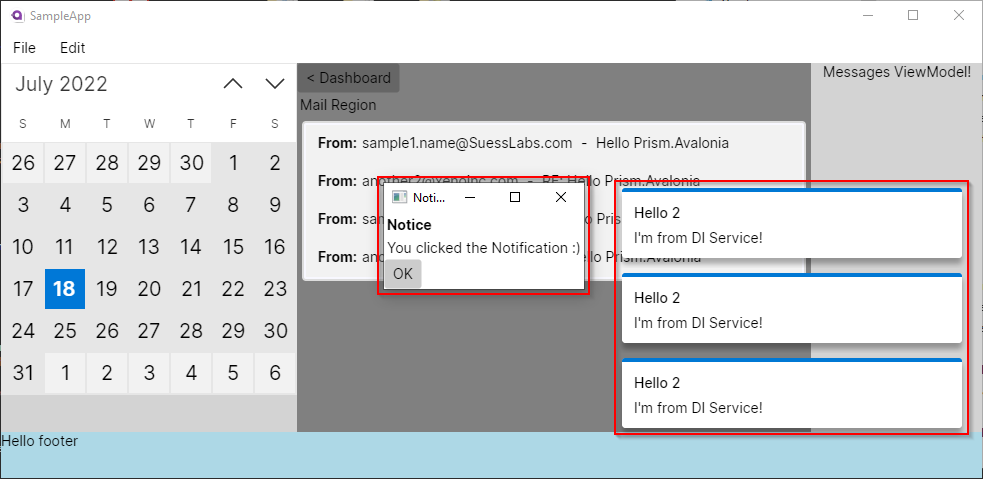Prism.Avalonia is officially moving to Prism Library!
Follow the PR for more information.Until full integration, keep reaching out on this site.
Thank you all for helping to mature and make this project into what it is today. I look forward to continuing efforts on Prism Avalonia as part of the official package.
See you over there for future releases!
- Damian
Prism.Avalonia provides your cross-platform Avalonia apps with Prism library support so you can Navigate, create Dialog Windows and Notifications, provide Dependency Injection and internal Messaging easier than before! To help get started, check out the official Prism.Avalonia Templates for Visual Studio.
For more samples outside of this repo, check out:
- Avalonia Outlookish
- Learn PrismLibrary
- If you have samples, let us know and we'll feature them!
Prism.Avalonia's logic and development approach is similar to that of Prism for WPF so can get started right away! Keep in mind, they are similar and not 1-to-1. Check out our Wiki and Avalonia Outlookish app for tips and tricks.
This project currently supports cross-platform Desktop applications (Windows, Linux, Mac). Support for Android, iOS, and web apps is still under evaluation; and is not 100%. Feel free to contribute and help us improve. 😃
Just like Prism.WPF or Prism.Maui, your project must reference both the Prism.Avalonia (Core) and Prism.DryIoc.Avalonia (IoC container) packages to work.
| Package | Stable | Preview |
|---|---|---|
| Prism.Avalonia |  |
 |
| Prism.DryIoc.Avalonia |  |
 |
Choose the NuGet package version that matches your Avalonia version.
Our versioning schema is based on the SemVer using the format MAJOR.MINOR.PATCH.REVISION. The REVISION segment indicates the Avalonia version support. For instance v9.0.537.11234 equates to, Prism v9.0.537, Avalonia v11.2.3, revision 4.
| Prism | Avalonia | Prism.Avalonia NuGet Package |
|---|---|---|
| v8.1.97 | 11.0.7 | v8.1.97.11073 (Core) (DryIoc) |
| v8.1.97 | 0.10.21 | v8.1.97.1021 (Core) (DryIoc) |
Be sure to check out the ChangeLog.md and guides when upgrading your NuGet packages:
- Upgrading to Prism v9.0.x-pre
- Upgrading to Avalonia-11
- Also, the official Avalonia Upgrading from v0.10.
See also, Contributing.md
Prism.Avalonia is an open-source project under the MIT license. We encourage community members like yourself to contribute.
You can contribute today by creating a feature request, issue, or discussion on the forum. From there we can have a brief discussion as to where this fits into the backlog priority. If this is something that fits within the Prism architecture, we'll kindly ask you to create a Pull Request. Any PR made without first having an issue/discussion may be closed.
Issues posted without a description may be closed immediately. Use the discussion boards if you have a question, not Issues.
Add the Prism.Avalonia and its DryIoc packages to your project:
# Legacy: Avalonia v11.0
Install-Package Prism.Avalonia -Version 8.1.97.11073
Install-Package Prism.DryIoc.Avalonia -Version 8.1.97.11073
# Legacy: Avalonia v0.10.1021
Install-Package Prism.Avalonia -Version 8.1.97.1021
Install-Package Prism.DryIoc.Avalonia -Version 8.1.97.1021The default Avalonia entrypoint Program.cs does not need to be modified. Below is provided as a sample.
using System;
using Avalonia;
namespace SampleBaseApp;
internal sealed class Program
{
// Initialization code. Don't use any Avalonia, third-party APIs or any
// SynchronizationContext-reliant code before AppMain is called
[STAThread]
public static void Main(string[] args) => BuildAvaloniaApp()
.StartWithClassicDesktopLifetime(args);
// Avalonia configuration, don't remove; also used by visual designer.
public static AppBuilder BuildAvaloniaApp()
=> AppBuilder.Configure<App>()
.UsePlatformDetect()
.WithInterFont()
.LogToTrace();
}<Application xmlns="https://github.com/avaloniaui"
xmlns:x="http://schemas.microsoft.com/winfx/2006/xaml"
x:Class="SampleBaseApp.App"
xmlns:local="using:SampleBaseApp"
RequestedThemeVariant="Default">
<!-- RequestedThemeVariant allows for the following types, "Default", "Dark", or "Light". -->
<Application.Styles>
<FluentTheme />
</Application.Styles>
</Application>Notice:
We do not need the
OnFrameworkInitializationCompleted()method. However, you must includebase.Initialize();in theInitialize()method to kick-start Prism.Avalonia.Also, in your
App.axamlyou no longer need to device the<Design.DataContext>. Prism takes care of this for you! (:
using System;
using Avalonia;
using Avalonia.Markup.Xaml;
using Prism.DryIoc;
using Prism.Ioc;
using SampleBaseApp.Views;
namespace SampleBaseApp;
public partial class App : PrismApplication
{
public override void Initialize()
{
AvaloniaXamlLoader.Load(this);
base.Initialize(); // Required to initialize Prism.Avalonia - DO NOT REMOVE
}
protected override AvaloniaObject CreateShell()
{
Console.WriteLine("CreateShell()");
return Container.Resolve<MainWindow>();
}
protected override void RegisterTypes(IContainerRegistry containerRegistry)
{
// Add Services and ViewModel registrations here
Console.WriteLine("RegisterTypes()");
// Services
//// containerRegistry.RegisterSingleton<ISampleService, ISampleService>();
// Views - Region Navigation
//// containerRegistry.RegisterForNavigation<DashboardView, DashboardViewModel>();
// Dialogs
//// containerRegistry.RegisterDialog<MessageBoxView, MessageBoxViewModel>();
//// containerRegistry.RegisterDialogWindow<CustomDialogWindow>(nameof(CustomDialogWindow));
}
protected override void ConfigureModuleCatalog(IModuleCatalog moduleCatalog)
{
// Register modules
//// moduleCatalog.AddModule<DummyModule.DummyModule1>();
}Below is a basic branching hierarchy and strategy.
| Branch | Purpose |
|---|---|
master |
All releases are tagged published using the master branch |
develop |
The default & active development branch. When a feature set is completed and ready for public release, the develop branch will be merged into master and a new NuGet package will be published. |
feature/* |
New feature branch. Once completed, it is merged into develop and the branch must be deleted. |
stable/* |
Stable release base build which shares cherry-picked merges from develop. This branch must not be deleted. |
See, Code of Conduct
See, Security
Sponsored by: Suess Labs a subsidary of Xeno Innovations, Inc.

